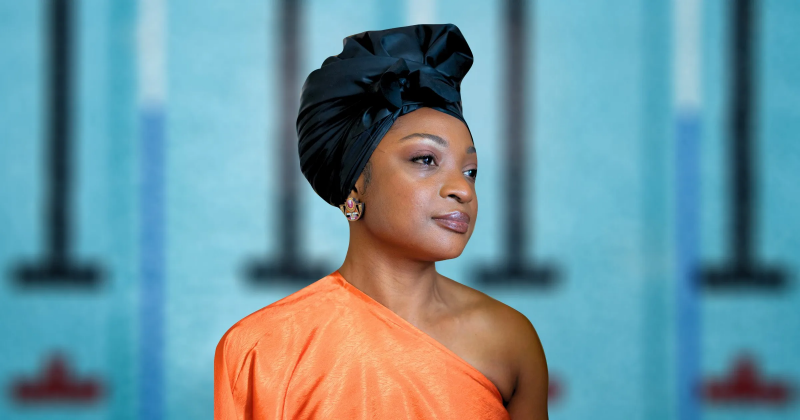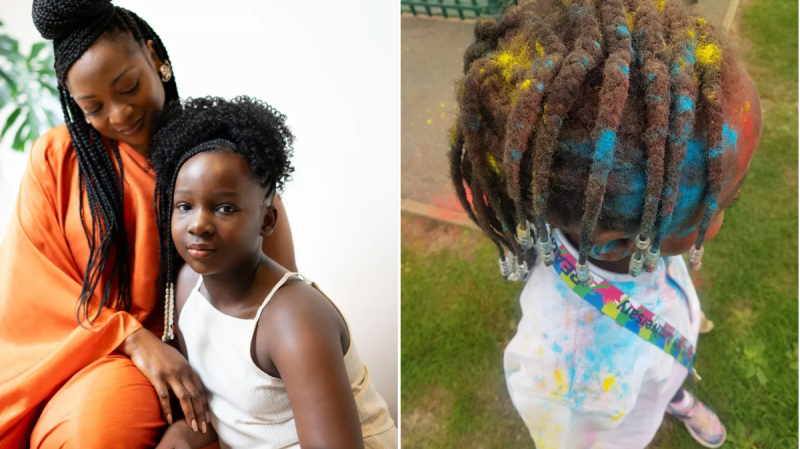
When Danielle Obe turned on the shower after her daughter Kayla’s swimming lesson, she had no idea of the chaos which would ensue.
Like many children, Kayla was not a fan of having her hair washed. But the four-year-old’s swimming cap would often let water in during lessons, which spread chlorine water across her thick hair. A shampoo and conditioning process to reduce the potential damage to her hair health could take anywhere between 35 minutes to an hour.
On one particular occasion at a leisure centre in Kent, Kayla was left wailing after yet another swimming cap had broken – which led to yet another dreaded hair wash.
‘She was screaming “no mummy, no mummy” while we were in a closed shower cubicle,’ Danielle tells Metro. ‘I was trying to reassure her by saying “calm down” but she was terrified about getting the water in her eyes. A passer-by had grown concerned with the screaming and reported us to reception, telling them there was a child in distress.
‘A few minutes later, I was still in the shower with a frantic Kayla, when there was a knock on the cubicle.’

With a bottle of shampoo in one hand, a towel in the other and a daughter in the shower, Danielle tentatively opened the door to find a concerned duty manager with another staff member from the sports club who identified themselves as the safeguarding lead.
The pair started to ‘interrogate’ young Kayla and her mother.
‘It all happened so fast,’ Danielle recalls. ‘They said there had been reports of a child in distress. Panicking, I caught myself and said to Kayla, “Calm down honey, can you tell these lovely ladies why you’re screaming?” Kayla cried “I don’t want to get my hair washed.”
Danielle was forced to explain to the staff members – who were both white – how most swim caps aren’t made for people of African, Caribbean and Asian heritage, and aren’t designed for textured hair like theirs.
After she desperately explained how this one had failed her daughter and the damage the chlorine could cause to Kayla’s hair, the staff left the shellshocked mother and her daughter alone.

However, Danielle is all too aware of how a situation like that could have ended up being escalated to child protection services.
‘We were just a handful of Afro Caribbeans who attended the club,’ the mum-of-three explains.
‘We could be there six out of seven days some weeks; for tennis, badminton, kids clubs, lunch. My kids were home-schooled so we’d utilise the club for curricular activities, often during school hours. As a result, the staff knew us and we had built a good rapport with them. If that hadn’t been the case, I really believe I would have had a social services involvement on my hands. We could have found ourselves in a lot of trouble.’
Understandably, Danielle was brought to tears after the misunderstanding at the sports club. Tending to her children’s hair was a ‘labour of love’ which had now been ruined by a flimsy swim cap, so she vowed to Kayla she would find a way so she could take part in any activity without fearing damage to her hair.
Just a few weeks later, Eliora, Danielle’s younger daughter, took part in a Colour Run [which sees powdered paint thrown at runners as they complete a 5k race] at school. As she watched two Black teachers hastily fashioned Sainsbury’s plastic bags into emergency waterproof head-pieces to protect their hair from the powdered paint, Danielle realised she had to make the change she wanted to see.

Danielle explains: ‘I wanted Kayla to have the option to swim or dance in the rain, without worrying about her hair.
‘Not long later, I was doing the dishes and just had this divinely inspired idea. As a women of colour, I wrapped my hair to do anything – could there be a waterproof version people could use?’
Danielle began to research swim caps on the market and develop her dream.
She wanted to create waterproof headscarves that were not pre-tied, which meant users had the ability to control the fit and comfort of the product themselves, avoiding breakage and damage to the hairline.
After a false start in 2019 – the supplier she initially chose sent out what she describes as ‘bin bag’ material – she reached out to the company JustGood who ‘understood the vision’, and two years later she launched her revolutionary swim cap range, called Obé.
Soon thousands of emails came into Danielle from across the world.

A volleyball team in Cabo Verde got in touch and explained how they used plastic bags or even cling film to protect their hair when it rained during practice sessions. One mum in England explained that her son, whose thick hair was in a top knot, hadn’t been able to take part in swimming lessons previously. Even a white woman in Florida put in an order, stating that her thick and curly hair would rarely fit in a normal swimming cap.
‘All these messages felt like hope,’ Danielle recalls. ‘I had thought I was working towards a change required for my daughter . But I soon realised it was much more than that.
‘Water is the essence of all our lives. It heals, calms and purifies us. Meanwhile our hair is our crowning jewel, it’s our heritage, it’s our power.’
Danielle, who has a background in management consulting, hopes her products will also encourage greater education about water safety, as statistics from Sport England show that 95% of Black adults and 80% of Black children in England don’t swim.
In some cultures, young people are brought up to treat water like they would a fire, and stay away from it. They’ve only experienced water in terms of a shower or a bath.
The Black Swimming Association found that hair was the most common barrier for participation amongst respondents who identified as Black. Largely because textured hair can be very expensive to maintain, style, and protect to limit damage, meaning some Black people avoid learning to swim.
However, being able to swim, and having water safety knowledge are more than just life skills, they are basic human rights, mum-of-three Danielle stresses.
‘This is about the power of the water but also the power of our voice,’ she adds. ‘We want to embolden and empower an entire population to take on something which has incredible benefits.
‘Aquatics has done so much for my career, my well-being and my family. Now, we all have the chance to be the architects and custodians of change.’
To find out more about Obé, click here. You can find out more information about the BSA, click here
Do you have a story you’d like to share? Get in touch by emailing Kirsten.Robertson@metro.co.uk
Share your views in the comments below.
Sign up to our guide to what’s on in London, trusted reviews, brilliant offers and competitions. London’s best bits in your inbox
Disclaimer: The copyright of this article belongs to the original author. Reposting this article is solely for the purpose of information dissemination and does not constitute any investment advice. If there is any infringement, please contact us immediately. We will make corrections or deletions as necessary. Thank you.




